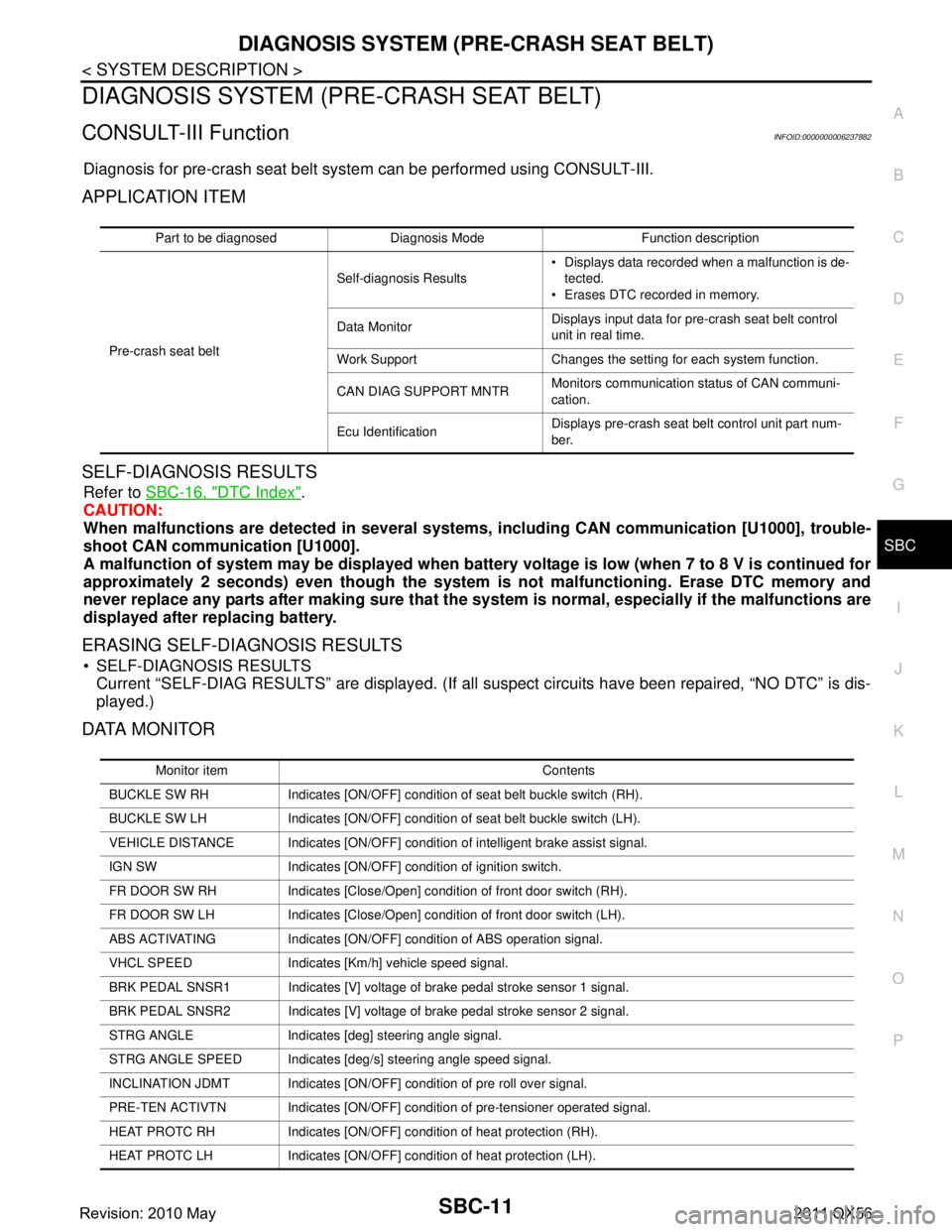2011 INFINITI QX56 change time
[x] Cancel search: change timePage 4243 of 5598

SQUEAK AND RATTLE TROUBLE DIAGNOSESRF-29
< SYMPTOM DIAGNOSIS >
C
DE
F
G H
I
J
L
M A
B
RF
N
O P
3. Trunk lid torsion bars knocking together
4. A loose license plate or bracket
Most of these incidents can be repaired by adjusting, se curing, or insulating the item(s) or component(s) caus-
ing the noise.
SUNROOF/HEADLINING
Noises in the sunroof / headlining area can of ten be traced to one of the following items:
1. Sunroof lid, rail, linkage, or seals making a rattle or light knocking noise
2. Sunvisor shaft shaking in the holder
3. Front or rear windshield touching headlining and squeaking
Again, pressing on the components to stop the noise while duplicating the conditions can isolate most of these
incidents. Repairs usually consist of insulating with felt cloth tape.
SEATS
When isolating seat noise it is important to note the position the seat is in and the load placed on the seat
when the noise occurs. These conditions should be duplic ated when verifying and isolating the cause of the
noise.
Causes of seat noise include:
1. Headrest rods and holder
2. A squeak between the seat pad cushion and frame
3. The rear seatback lock and bracket
These noises can be isolated by moving or pressing on the suspected components while duplicating the con-
ditions under which the noise occurs. Most of thes e incidents can be repaired by repositioning the component
or applying urethane tape to the contact area.
UNDERHOOD
Some interior noise may be caused by components under the hood or on the engine wall. The noise is then
transmitted into the passenger compartment.
Causes of transmitted underhood noise include:
1. Any component mounted to the engine wall
2. Components that pass through the engine wall
3. Engine wall mounts and connectors
4. Loose radiator mounting pins
5. Hood bumpers out of adjustment
6. Hood striker out of adjustment
These noises can be difficult to isolate since they cannot be reached from the interior of the vehicle. The best
method is to secure, move, or insulate one component at a time and test drive the vehicle. Also, engine RPM
or load can be changed to isolate the noise. Repairs c an usually be made by moving, adjusting, securing, or
insulating the component causing the noise.
Revision: 2010 May2011 QX56
Page 4308 of 5598

DIAGNOSIS SYSTEM (PRE-CRASH SEAT BELT)SBC-11
< SYSTEM DESCRIPTION >
C
DE
F
G
I
J
K L
M A
B
SBC
N
O P
DIAGNOSIS SYSTEM (P RE-CRASH SEAT BELT)
CONSULT-III FunctionINFOID:0000000006237882
Diagnosis for pre-crash seat belt syst em can be performed using CONSULT-III.
APPLICATION ITEM
SELF-DIAGNOSIS RESULTS
Refer to SBC-16, "DTC Index".
CAUTION:
When malfunctions are detect ed in several systems, includin g CAN communication [U1000], trouble-
shoot CAN communication [U1000].
A malfunction of system may be disp layed when battery voltage is low (when 7 to 8 V is continued for
approximately 2 seconds) even though the system is not malfunctioning. Erase DTC memory and
never replace any parts after making sure that the syst em is normal, especially if the malfunctions are
displayed after replacing battery.
ERASING SELF-DIAGNOSIS RESULTS
SELF-DIAGNOSIS RESULTS Current “SELF-DIAG RESULTS” are displayed. (If all suspect circuits have been repaired, “NO DTC” is dis-
played.)
DATA MONITOR
Part to be diagnosed Diagnosis Mode Function description
Pre-crash seat belt Self-diagnosis Results
Displays data recorded when a malfunction is de-
tected.
Erases DTC recorded in memory.
Data Monitor Displays input data for pre-crash seat belt control
unit in real time.
Work Support Changes the setting for each system function.
CAN DIAG SUPPORT MNTR Monitors communication status of CAN communi-
cation.
Ecu Identification Displays pre-crash seat belt control unit part num-
ber.
Monitor item Contents
BUCKLE SW RH Indicates [ON/OFF] condition of seat belt buckle switch (RH).
BUCKLE SW LH Indicates [ON/OFF] condition of seat belt buckle switch (LH).
VEHICLE DISTANCE Indicates [ON/OFF] condit ion of intelligent brake assist signal.
IGN SW Indicates [ON/OFF] condition of ignition switch.
FR DOOR SW RH Indicates [Close/Open] condition of front door switch (RH).
FR DOOR SW LH Indicates [Close/Open] condition of front door switch (LH).
ABS ACTIVATING Indicates [ON/OFF] co ndition of ABS operation signal.
VHCL SPEED Indicates [Km/h] vehicle speed signal.
BRK PEDAL SNSR1 Indicates [V] voltage of brake pedal stroke sensor 1 signal.
BRK PEDAL SNSR2 Indicates [V] voltage of brake pedal stroke sensor 2 signal.
STRG ANGLE Indicates [deg] steering angle signal.
STRG ANGLE SPEED Indicates [deg/s] steering angle speed signal.
INCLINATION JDMT Indicates [ON/OFF] condition of pre roll over signal.
PRE-TEN ACTIVTN Indicates [ON/OFF] condition of pre-tensioner operated signal.
HEAT PROTC RH Indicates [ON/OFF] condition of heat protection (RH).
HEAT PROTC LH Indicates [ON/OFF] condition of heat protection (LH).
Revision: 2010 May2011 QX56
Page 4309 of 5598

SBC-12
< SYSTEM DESCRIPTION >
DIAGNOSIS SYSTEM (PRE-CRASH SEAT BELT)
WORK SUPPORT
Monitor item Description
DOOR OPENING RETRACT RETRY Changes the number of times for the seat belt retract retry when the door opens.
Revision: 2010 May2011 QX56
Page 4416 of 5598
![INFINITI QX56 2011 Factory Service Manual
SCS-56
< SYSTEM DESCRIPTION >[AIR LEVELIZER CONTROL SYSTEM]
DIAGNOSIS SYSTEM (AIR
LEVELIZER CONTROL MODULE)
DIAGNOSIS SYSTEM (AIR LE VELIZER CONTROL MODULE)
CONSULT-III FunctionINFOID:00000000062560 INFINITI QX56 2011 Factory Service Manual
SCS-56
< SYSTEM DESCRIPTION >[AIR LEVELIZER CONTROL SYSTEM]
DIAGNOSIS SYSTEM (AIR
LEVELIZER CONTROL MODULE)
DIAGNOSIS SYSTEM (AIR LE VELIZER CONTROL MODULE)
CONSULT-III FunctionINFOID:00000000062560](/manual-img/42/57033/w960_57033-4415.png)
SCS-56
< SYSTEM DESCRIPTION >[AIR LEVELIZER CONTROL SYSTEM]
DIAGNOSIS SYSTEM (AIR
LEVELIZER CONTROL MODULE)
DIAGNOSIS SYSTEM (AIR LE VELIZER CONTROL MODULE)
CONSULT-III FunctionINFOID:0000000006256052
CONSULT-III APPLICATION ITEMS
WORK SUPPORT
CAUTION:
Perform the procedure when the vehicle is stopped.
SELF DIAGNOSTIC RESULTS
Refer to SCS-59, "DTC Index".
When “CRNT” is displayed on self-diagnosis result,
The system is presently malfunctioning.
When “PAST” is displayed on self-diagnosis result, System malfunction in the past is detect ed, but the system is presently normal.
Freeze frame data (FFD)
DATA MONITOR
Diagnostic test mode Function
Work Support This mode enables a technician to adjust some devices faster and more accurately.
Self Diagnostic Results Retrieve DTC from ECU and display diagnostic items.
Data Monitor Monitor the input/output signal of the control unit in real time.
CAN Diagnosis This mode displays a network diagnosis result about CAN by a diagram.
CAN Diagnostic Support
Monitor It monitors the status of CAN communication.
ECU Identification Display the ECU identification number (part number etc.) of the selected system.
Active Test Send the drive signal from CONSULT-III to the actuator. The operation check can be performed.
Item name Description
STANDARD HEIGHT LEVEL Forcibly sets vehicle height to the set standard vehicle height.
ADJUST HEIGHT INI Sets standard vehicle height.
CLEAR HEIGHT INI Erases standard vehicle height.
Item name Description
IGN COUNTER The number of times that ignition switch is turned ON after the DTC is detected is displayed.
When “0” is displayed: It indicates that the system is presently malfunctioning.
When except “0” is displayed: It indicates that system malfunction in the past is detected, but the system
is presently normal.
NOTE:
Each time when ignition switch is turned OFF to ON, numerical number increases in 1 → 2 → 3...38 → 39.
When the operation number of times exceeds 39, the number do not increase and “39” is displayed until
self-diagnosis is erased.
Monitored item (Unit) Remarks
IGN VOLT (V) Displays the power supply voltage of air levelizer control module.
VHCL HT INTLZ STA Displays setting status of standard vehicle height.
VHCL HT INIT SLCT Displays setting status of standard vehicle height.
VHCL HEIGHT SEN (V) Displays the signal voltage of vehicle height sensor.
VHCL HT CNVSN VL (mm) Displays the vehicle height recognized by air levelizer control module.
VHCL HGT FIX TIME (hour) Displays period of time that signal from vehicle height sensor does not change.
Revision: 2010 May2011 QX56
Page 4441 of 5598
![INFINITI QX56 2011 Factory Service Manual
C1806 VHCL HEIGHT SEN FIXSCS-81
< DTC/CIRCUIT DIAGNOSIS > [AIR LEVELIZER CONTROL SYSTEM]
C
D
F
G H
I
J
K L
M A
B
SCS
N
O P
C1806 VHCL HEIGHT SEN FIX
DTC LogicINFOID:0000000006256076
DTC DETECTION LOG INFINITI QX56 2011 Factory Service Manual
C1806 VHCL HEIGHT SEN FIXSCS-81
< DTC/CIRCUIT DIAGNOSIS > [AIR LEVELIZER CONTROL SYSTEM]
C
D
F
G H
I
J
K L
M A
B
SCS
N
O P
C1806 VHCL HEIGHT SEN FIX
DTC LogicINFOID:0000000006256076
DTC DETECTION LOG](/manual-img/42/57033/w960_57033-4440.png)
C1806 VHCL HEIGHT SEN FIXSCS-81
< DTC/CIRCUIT DIAGNOSIS > [AIR LEVELIZER CONTROL SYSTEM]
C
D
F
G H
I
J
K L
M A
B
SCS
N
O P
C1806 VHCL HEIGHT SEN FIX
DTC LogicINFOID:0000000006256076
DTC DETECTION LOGIC
DTC CONFIRMATION PROCEDURE
1.PRECONDITIONING
If “DTC CONFIRMATION PROCEDURE” has been previous ly conducted, always turn ignition switch OFF
andwait at least 10 seconds before conducting the next test.
>> GO TO 2.
2.CHECK VEHICLE HEIGHT SENSOR FIXATION
With CONSULT-III
1. Start the engine.
2. Select “VHCL HEIGHT SEN” in “Data Monitor” in “E-SUS”.
3. Drive vehicle and maintain the following conditions for 5 minutes or more.
Does the value of
“VHCL HEIGHT SEN” change?
YES >> INSPECTION END
NO >> Go to SCS-81, "
Diagnosis Procedure".
Diagnosis ProcedureINFOID:0000000006256077
1.CHECK APPEARANCE
Visually check for installation malfunction, or deformation of vehicle height sensor.
Is the inspection result normal?
YES >> GO TO 2.
NO >> Repaire or replace damaged parts.
2.CHECK VEHICLE HEIGHT SENSOR
Check the vehicle height sensor. Refer to SCS-70, "
Component Inspection".
Is the inspection result normal?
YES >> Check intermittent incident. Refer to GI-40, "Intermittent Incident".
NO >> Replace the vehicle height sensor. Refer to SCS-98, "
Removal and Installation".
DTC Display item Malfunction detected condition Possible cause
C1806 VHCL HEIGHT SEN FIX The signal voltage of the vehicle height sensor does
not change for cumulated time of 100 hours under the
condition that the air levelizer control module outputs
sensor voltage (4.5 – 5.5 V) with vehicle speeds 2
km/h (2 MPH) or more. Harness or connector
Vehicle height sensor
Vehicle speed : 5 km/h (3 MPH) or more
Revision: 2010 May2011 QX56
Page 4478 of 5598

SYSTEMSE-19
< SYSTEM DESCRIPTION >
C
DE
F
G H
I
K L
M A
B
SE
N
O P
*: System voltage is the voltage between the climate controlled seat control unit power source and ground.
NOTE:
When the ignition status changes to OFF during the fail-safe mode, the control unit shall enter the OFF condition. If the ignit ion is turned
ON, the system shall return to the standby mode. If the system en ters in the fail-safe mode again after performing ignition cycle, start the
diagnosis. HEAT or COOL switch input out of the specified range
During the standby mode, heating or cooling states, if the rotary switch
input is 6% or less of the vehicle battery voltage, it stops all output and
enters the system OFF condition
When the switch input returns to a value within the specified range, the system recovers automatically
System voltage out of range If the system voltage at the climate controlled seat control unit falls out-
side of the 8.5 to 16.5 V operating range, it stops all output after a 500ms
time period.
When the system voltage returns to the normal operating range (10.5-
15.5V with a 500ms hysteresis), the system recovers automatically.
Malfunction Malfunctioning condition
Revision: 2010 May2011 QX56
Page 4482 of 5598

CLIMATE CONTROLLED SEAT CONTROL UNITSE-23
< ECU DIAGNOSIS INFORMATION >
C
DE
F
G H
I
K L
M A
B
SE
N
O P
*: System voltage is the voltage between the climate controlled seat control unit power source and ground.
NOTE:
When the ignition status changes to OFF during the fail-safe mode, the control unit shall enter the OFF condition. If the ignit ion is turned
ON, the system shall return to the standby mode. If the system en ters in the fail-safe mode again after performing ignition cycle, start the
diagnosis. HEAT or COOL switch input out of the specified range
During the standby mode, heating or cooling states, if the rotary switch
input is less than 6% of the vehicle battery voltage, it stops all output and
enters the system OFF condition
When the switch input returns to a value within the specified range, the system recovers automatically
System voltage out of range If the system voltage at the climate controlled seat control unit falls out-
side of the 8.5 to 16.5 V operating range, it stops all output after a 500ms
time period.
When the system voltage returns to the normal operating range (10.5-
15.5V with a 500ms hysteresis), the system recovers automatically.
Malfunction Malfunctioning condition
Revision: 2010 May2011 QX56
Page 4561 of 5598

SE-102
< SYMPTOM DIAGNOSIS >
SQUEAK AND RATTLE TROUBLE DIAGNOSES
Most of these incidents can be repaired by adjusting, securing or insulating the item(s) or component(s) caus-
ing the noise.
SUNROOF/HEADLINING
Noises in the sunroof/headlining area c an often be traced to one of the following:
1. Sunroof lid, rail, linkage or seals making a rattle or light knocking noise
2. Sunvisor shaft shaking in the holder
3. Front or rear windshield touching headlining and squeaking
Again, pressing on the components to stop the noise while duplicating the conditions can isolate most of these
incidents. Repairs usually consist of insulating with felt cloth tape.
SEATS
When isolating seat noise it's important to note the position the seats in and the load placed on the seat when
the noise occurs. These conditions should be duplicated when verifying and isolating the cause of the noise.
Cause of seat noise include:
1. Headrest rods and holder
2. A squeak between the seat pad cushion and frame
3. The rear seatback lock and bracket
These noises can be isolated by moving or pressing on the suspected components while duplicating the con-
ditions under which the noise occurs.Most of these incidents can be repaired by repositioning the component
or applying urethane tape to the contact area.
UNDERHOOD
Some interior noise may be caused by components under the hood or on the engine wall. The noise is then
transmitted into the passenger compartment.
Causes of transmitted underhood noise include:
1. Any component mounted to the engine wall
2. Components that pass through the engine wall
3. Engine wall mounts and connectors
4. Loose radiator mounting pins
5. Hood bumpers out of adjustment
6. Hood striker out of adjustment
These noises can be difficult to isolate since they cannot be reached from the interior of the vehicle. The best
method is to secure, move or insulate one component at a time and test drive the \
vehicle. Also, engine RPM
or load can be changed to isolate the noise. Repairs can usually be made by moving, adjusting, securing, or
insulating the component causing the noise.
Revision: 2010 May2011 QX56